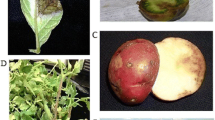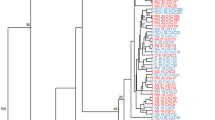Abstract
Phytophthora infestans causes late blight of potato and tomato, a disease that has been estimated to cost U.S. potato growers $287.8 million annually. We collected isolates of P. infestans from Wisconsin from 2009 to 2012 and determined distribution of clonal lineages and mating types and sensitivity to the systemic fungicide mefenoxam. We also sought to evaluate the current utility of an analysis of the Glucose-6-phosphate isomerase (Gpi) allozyme locus for predicting mefenoxam sensitivity with the aim of delivering timely information to growers. Overall, 143 isolates were collected from 52 locations in 20 Wisconsin counties from 2009 to 2012. Three clonal lineages, US-22, US-23, and US-24, were identified and were novel to Wisconsin and the U.S. US-22 is of the A2 mating type and sensitive to mefenoxam, with Gpi 100/122. US-23 and US-24 are of the A1 mating type and primarily intermediately sensitive to mefenoxam, with Gpi 100/100 and 100/100/111, respectively. Because of this close correlation and the unique Gpi patterns for each lineage present, we were able to predict mefenoxam sensitivity directly from samples using the allozyme assay and quickly deliver management information to growers. Both mating types were present in Wisconsin in 2009 and 2010 but were spatially separated and no evidence of sexual recombination or soil persistence was detected. The presence of new clonal lineages of P. infestans in Wisconsin indicates a need for continued close monitoring of late blight to facilitate generation of timely information for enhanced short-term and long-term late blight management.
Resumen
Phytophthora infestans causa el tizón tardío de la papa y el tomate, una enfermedad a la que se le ha estimado un costo para los productores de papa de los EUA de $ 287.8 millones de dólares anualmente. Colectamos aislamientos de P. infestans de Wisconsin de 2009 a 2012 y se determinó la distribución de linajes clonales y grupos de compatibilidad y sensibilidad al fungicida sistémico mefenoxam. También buscamos evaluar la utilidad actual de un análisis del locus de la aloenzima Glucosa-6-fosfato isomerasa (Gpi) para la predicción de la sensibilidad al mefenoxam, con el propósito de entregar información oportuna a los productores. En total, se colectaron 143 aislamientos de 52 localidades en 20 condados de Wisconsin del 2009 al 2012. Se identificaron tres linajes clonales, US-22, US 23 y US 24, que fueron novedosos para Wisconsin y para los EUA. El US-22 es del grupo de compatibilidad A2 y sensible a mefenoxam, con Gpi 100/122. El US-23 y el US-24 son del tipo A1, y al principio de sensibilidad intermedia al mefenoxam, con Gpi de 100/100 y 100/100/111, respectivamente. Debido a esta correlación tan estrecha y a los patrones tan singulares de Gpi para cada linaje presente, estuvimos en condiciones de predecir la sensibilidad al mefenoxam directamente de muestras usando el ensayo de las aloenzimas y proporcionar rápidamente información de manejo a los productores. Los dos grupos de compatibilidad estuvieron presentes en Wisconsin en 2009 y 2010 pero estuvieron separados espacialmente y no se detectó evidencia de recombinación sexual o persistencia en el suelo. La presencia de nuevos linajes clonales de P. infestans en Wisconsin indica la necesidad de monitoreo continuo y cercano del tizón tardío para facilitar la generación de información oportuna para un manejo aumentado a corto y largo plazo del tizón tardío.



Similar content being viewed by others
References
Caten, C.E., and J.L. Jinks. 1968. Spontaneous variability of single isolates of Phytophthora infestans. I. Cultural variation. Canadian Journal of Botany 46: 329–348.
Cohen, Y., M. Reuveni, and H. Eyal. 1979. The systemic antifungal activity of Ridomil against Phytophthora infestans on tomato plants. Phytopathology 69: 645–649.
Daayf, F., H.W. Platt, and R.D. Peters. 2000. Changes in mating types, resistance to metalaxyl, and Gpi-allozyme genotypes of Phytophthora infestans in Canadian provinces from 1996 to 1998. Canadian Journal of Plant Pathology 22: 110–116.
Deahl, K.L., S.P. DeMuth, S.L. Sinden, and A. Rivera-Peña. 1995. Identification of mating types and metalaxyl resistance in North American populations of Phytophthora infestans. American Potato Journal 72: 35–49.
Enloe, J. 2012. National Climate Data Center Plot Time Series. National Oceanic and Atmospheric Administration. Retreived 11 October 2012 from http://www.ncdc.noaa.gov/temp-and-precip/time-series/index.php.
Erwin, D.C., and O.K. Ribeiro. 1996. Phytophthora diseases worldwide, 43–44. St. Paul: APS Press.
Fay, J.C., and W.E. Fry. 1997. Effects of hot and cold temperatures on the survival of oospores produced by United States strains of Phytophthora infestans. American Journal of Potato Research 74: 315–323.
Fry, W.E., McGrath, M.T., Seaman, A., Zitter, T.A., McLeod, A., Danies, G., Small, I.M., Myers, K., Everts, K., Gevens, A.J. Gugino, B.K., Johnson, S.B., Judelson, H., Ristaino, J.B., Roberts, P., Secor, G., Seebold, K.W., Snover-Clift, K.L., Wyenandt, A., Grunwald, N.J., and C.D. Smart. 2012. The 2009 late blight pandemic in the eastern United States - Causes and results. Plant Disease 97: 296–306.
Gevens, A.J., and A.C. Seidl. 2013a. First report of late blight caused by Phytophthora infestans clonal lineage US-23 on tomato and potato in Wisconsin, United States. Plant Disease 97: 839.
Gevens, A.J., and A.C. Seidl. 2013b. First report of late blight caused by Phytophthora infestans clonal lineage US-22 on tomato and potato in Wisconsin. Plant Disease 97: 432.
Gevens, A.J., and A.C. Seidl. 2013c. First report of late blight caused by Phytophthora infestans clonal lineage US-24 on potato (Solanum tuberosum) in Wisconsin. Plant Disease 97: 152.
Gevens, A.J., Seidl, A.C., Clark, R., and A. Sanchez-Perez. 2011. Late blight management with new Phytophthora infestans genotypes. Proceedings of Wisconsin’s Annual Potato Meeting. University of Wisconsin-Madison, College of Agriculture and Life Sciences, Research Division, Stevens Point, WI, pp. 1–4.
Gomez-Alpizar, L., I. Carbone, and J.B. Ristaino. 2007. An Andean origin of Phytophthora infestans inferred from mitochondrial and nuclear gene genealogies. Proceedings of the National Academy of Sciences 104: 3306–3311.
Goodwin, S.B., B.A. Cohen, and W.E. Fry. 1994. Panglobal distribution of a single clonal lineage of the Irish potato famine fungus. Proceedings of the National Academy of Sciences 91: 11591–11595.
Goodwin, S.B., A. Drenth, and W.E. Fry. 1992. Cloning and genetic analyses of two highly polymorphic, moderately repetitive nuclear DNAs from Phytophthora infestans. Current Genetics 22: 107–115.
Goodwin, S.B., W.E. Fry, and R.E. Schneider. 1995a. Use of cellulose-acetate electrophoresis for rapid identification of allozyme genotypes of Phytophthora infestans. Plant Disease 79: 1181–1185.
Goodwin, S.B., L.S. Sujkowski, A.T. Dyer, B.A. Fry, and W.E. Fry. 1995b. Direct Detection of Gene Flow Probable Sexual Reproduction of Phytophthora infestans in Northern North America. Phytopathology 85: 473–479.
Goodwin, S.B., C.D. Smart, R.W. Sandrock, K.L. Deahl, Z.K. Punja, and W.E. Fry. 1998. Genetic change within populations of Phytophthora infestans in the United States and Canada during 1994 to 1996: Role of migration and recombination. Phytopathology 88: 939–949.
Groves, C.L. 2002. Characterization of Phytophthora infestans from Maine during 1999 and 2000. American Journal of Potato Research 79: 325–333.
Guenthner, J.F., K.C. Michael, and P. Nolte. 2001. The economic impact of potato late blight on U.S. growers. Potato Research 44: 121–125.
Haverkort, A.J., P.M. Boonekamp, R. Hutten, E. Jacobsen, L.A.P. Lotz, G.J.T. Kessel, R.G.F. Visser, and E.A.G. van der Vossen. 2008. Societal costs of late blight in potato and prospects of durable resistance through cisgenic modification. Potato Research 51: 47–57.
Hu, C.-H., F.G. Perez, R.S. Donahoo, A. McLeod, K. Myers, K. Ivors, G. Secor, P.D. Roberts, K.L. Deahl, W.E. Fry, and J.B. Ristaino. 2012. Recent genotypes of Phytophthora infestans in the eastern United States reveal clonal populations and reappearance of mefenoxam sensitivity. Plant Disease 96: 1323–1330.
Kalischuk, M., K.I. Al-Mughrabi, R.D. Peters, R.J. Howard, H.W. Platt, and L.M. Kawchuk. 2012. Genetic composition of Phytophthora infestans in Canada reveals migration and increased diversity. Plant Disease 96: 1729–1735.
Kawchuk, L.M., R.J. Howard, R.D. Peters, and K.I. Al-Mughrabi. 2011. First report of Phytophthora infestans genotype US23 causing late blight in Canada. Plant Disease 95: 873.
Lamour, K.H., and M.K. Hausbeck. 2001. Investigating the spaciotemporal genetic structure of Phytophthora capsici in Michigan. Phytopathology 91: 973–980.
Lees, A.K., R. Wattier, D.S. Shaw, L. Sullivan, N.A. Williams, and D.E.L. Cooke. 2006. Novel microsatellite markers for the analysis of Phytophthora infestans populations. Plant Pathology 55: 311–319.
Marshall-Farrar, K., M. McGrath, R.V. James, and W. Stevenson. 1998. Characterization of Phytophthora infestans in Wisconsin from 1993 to 1995. Plant Disease 82: 434–436.
National Agricultural Statistics Service, 2012. Crop production 2011 summary. United States Department of Agriculture, pp. 54–57
Ristaino, J.B. 2010. The 2009 potato and tomato late blight epidemics: Genealogical history, multiple sources and migration events. Phytopathology 100: S161.
Seidl, A.C., A.J. Mitchell, and A.J. Gevens. 2012. Assessing fitness of new Phytophthora infestans clonal lineages by comparing sporangial production on tomato leaves. Phytopathology 102: S5.9.
Shattock, R.C. 1988. Studies on the inheritance of resistance to metalaxyl in Phytophthora infestans. Plant Pathology 37: 4–11.
Stevenson, W.R. 2001. Potato disease management: One step forward and two steps back. Proceedings of Wisconsin’s annual potato meeting. University of Wisconsin, Madison, College of Agricultural and Life Sciences, Research Division, Wausau, Wisconsin, pp. 175–189.
Stevenson, W.R., and R.V. James. 1997. Improved management of early blight and late blight: What have we learned from 1996?, Proceedings of Wisconsin’s Annual Potato Meeting. University of Wisconsin, Madison, College of Agriculture and Life Sciences, Research Division, Stevens Point, WI, pp. 107–112.
Stevenson, W.R., and R.V. James. 1998. Lessons learned and applied in the management of potato late blight. Proceedings of Wisconsin’s Annual Potato Meetings. University of Wisconsin, Madison, College of Agriculture and Life Sciences, Research Division, Stevens Point, WI, pp. 155–161.
Stevenson, W.R., R. Loria, G.D. Franc, and D.P. Weingartner (eds.). 2001. Compendium of potato diseases, 28–30. St. Paul: APS Press.
University of Wisconsin Extension Ag Weather, 2010. Automated weather product subscriptions. University of Wisconsin. Accessed 29 May 2013. http://www.soils.wisc.edu/uwex_agwx/awon/daily_soil
Widmark, A.-K., B. Andersson, M. Sandstrom, and J.E. Yuen. 2011. Tracking Phytophthora infestans with SSR markers within and between seasons - a field study in Sweden. Plant Pathology 60: 938–945.
Acknowledgements
This work was supported, in part, by Hatch Formula Funds granted to Dr. Amanda Gevens at the University of Wisconsin-Madison and a Wisconsin Potato Industry Board-Wisconsin Distinguished Graduate Fellowship. The authors would like to thank Dr. William Fry and his laboratory staff at Cornell University for completing the RFLP analysis on several isolates. We would also like to thank Ms. Abigail Mitchell and Mr. Scott Donovan for technical assistance in the UW-Potato and Vegetable Pathology Laboratory. We also greatly appreciate the efforts of numerous extension specialists, county agents, crop consultants, and home gardeners for submitting diseased plant samples, without whom this work would not have been possible.
Author information
Authors and Affiliations
Corresponding author
Rights and permissions
About this article
Cite this article
Seidl, A.C., Gevens, A.J. Characterization and Distribution of Three New Clonal Lineages of Phytophthora infestans Causing Late Blight in Wisconsin from 2009 to 2012. Am. J. Potato Res. 90, 551–560 (2013). https://doi.org/10.1007/s12230-013-9328-x
Published:
Issue Date:
DOI: https://doi.org/10.1007/s12230-013-9328-x




